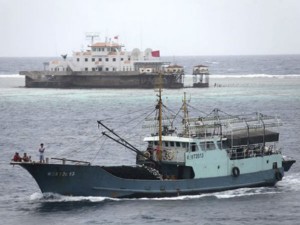
In this photo taken on Friday, July 20, 2012, a fishing boat sails past the Meiji reef off the island province of Hainan in the South China Sea. China has rolled out the red carpet for its newest city, on a small, remote island in the South China Sea that is also claimed by Vietnam. (AP Photo) CHINA OUT
WASHINGTON– China has raised the stakes in a potential regional flashpoint with its new city on a remote island in the contested West Philippine (South China Sea) and its plans for a military garrison there.
How might the United States respond?
Criticize Beijing too strongly and the Obama administration will strain its relationship with the emerging superpower. Let it pass and undermine two years of intense diplomacy that has promoted the US standing among Southeast Asian nations that are intimidated by China’s rise.
A key plank of the administration’s engagement in the Asia-Pacific since 2010 has been its declaration of a US national interest in peace and stability in the South China Sea, where China and five of its neighbors — most notably the Philippines and Vietnam — have competing territorial claims.
But tensions have only escalated. China’s raising of the flag this week at Sansha municipality, on tiny Yongxing island, 350 kilometers (220 miles) from its southernmost province of Hainan, came as claimants jockey for influence in the resource-rich region.
China will not be able to project much military power from such a small outpost — with a population of just 1,000 people and scarcely room for an airstrip — but it has symbolic importance. Beijing says the municipality will administer hundreds of thousands of square kilometers (miles) of water where it wants to strengthen its control over disputed — and potentially oil-rich — islands.
In Washington, lawmakers interested in Asia policy have been quick to respond. Republican Senator John McCain called the move provocative, and reinforced worries that China would attempt to impose its territorial claims through intimidation and coercion. Democrat Sen. Jim Webb said China’s attempt to assert control of disputed territories may be a violation of international law.
While the State Department was careful in its commentary, it also criticized China’s “unilateral moves.”
“I think there is a concern here, that they are beginning to take actions when we want to see all of these issues resolved at the table,” spokeswoman Victoria Nuland said Thursday.
President Barack Obama will not want to appear soft on China as he fights for re-election against Republican Mitt Romney who has accused the incumbent of being weak on Beijing and has vowed to get tough, in particular, on China’s trading practices.
However, the United States walks a fine line in its diplomacy on the South China Sea, always stressing it does not take a position on the competing sovereignty claims.
Defining it as a US national interest in 2010 helped galvanize Washington’s standing in the region, and revive its ties with treaty ally Manila and build a relationship with former enemy Hanoi. As part of its broader push or “pivot” toward Asia, the US elevated its engagement with the Association of Southeast Asian Nations, or ASEAN, and strongly supports the 10-nation bloc’s efforts to negotiate collectively with China on the issue and draft a code of conduct to help manage South China Sea disputes.
That’s annoyed China, which claims virtually the entire South China Sea and its island groups, and would prefer to negotiate with the other claimants individually. Beijing also views US intervention on the issue as encouraging Vietnam and the Philippines to be more confrontational in asserting their own claims.
When Chinese fishing boats were stopped by the Philippine vessels at the disputed Scarborough Shoal in April, inside what Manila regards as its exclusive economic zone, it deployed a navy ship supplied by the US the previous year. That prompted China to send more vessels of its own, escalating a standoff that rumbles on.
And the establishment of Sansha municipality in another portion of the South China Sea came after Vietnam passed a law in June stating its jurisdiction over the Paracel and Spratly Island chains and declaring that all foreign naval ships entering these areas must notify Vietnamese authorities.
The chance of such disputes spiraling into a major conflict still appears slim, but the stakes could rise in the years ahead as competition intensifies for the oil and gas resources in the South China Sea. China recently put out for tender exploration offshore blocks that overlap with areas already tendered by Vietnam, and Philippine drilling plans could also put it on collision course with China.
The US strategy for managing and eventually resolving these disputes largely hangs on the efforts of ASEAN. The bloc has made some progress in drafting a code of conduct, but there’s no sign of a lasting resolution of territorial disputes, and South China Sea is emerging as a divisive issue in a grouping that prizes its unity.
For the first time in its 45-year history, ASEAN failed to issue at communique at an annual meeting of its 10 foreign ministers this month, when host Cambodia, viewed as pro-Beijing, rejected a proposal by the Philippines and Vietnam to mention their separate territorial disputes with China in the statement.
In a damage-limitation exercise, ASEAN’s largest nation, Indonesia, brokered a compromise last week. But it’s one which will do little to assuage concerns of a rift within the grouping and a narrative that the Obama administration will be anxious to avoid: that the struggle over the South China Sea pits the strategic interests of the U.S. against China.

